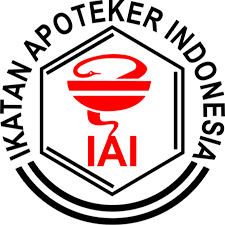Optimasi Konsentrasi Amylum Sagu (Metroxylon rumphii) sebagai Co-Processed pada Pembuatan Tablet Teofilin
Nor Laili(1*), Annisa' Meyndra Komala(2), Hidayaturrizqika Maulida(3), Suprapto Suprapto(4)(1) Fakultas Farmasi, Universitas Muhammadiyah Surakarta
(2) Fakultas Farmasi, Universitas Muhammadiyah Surakarta
(3) Fakultas Farmasi, Universitas Muhammadiyah Surakarta
(4) Fakultas Farmasi, Universitas Muhammadiyah Surakarta
(*) Corresponding Author
Abstract
Keywords
Full Text:
PDFReferences
Departemen Kesehatan Republik Indonesia. 2014. Farmakope Indonesia. Edisi V. Departemen Kesehatan Republik Indonesia. Jakarta.
Gohel, M.C., and Jogani, P.D., 2003. Investigation of direct compression characteristics of coprocessed lactose-starch using factorial design. Indian J Pharm Sci. 65 (1): 31-38.
Gohel, M. C. 2005. A Review of Co-processed Directly Compressible Excipients. J. Pharm Sci, 8 (1): 76-93.
Hadisoewignyo, L., dan Fudholi, A., 2013. Sediaan Solida. Pustaka Pelajar. Yogyakarta.
Hauschild, K., and Picker, K.M. 2004. Evaluation of New Coprocessed Compound Based on Lactose and Maize Starch for Tablet Formulation. Pharm Sci Tech. 6 (2).
Jaynes, J., Ding, X., Xu, H., Wong, W. K., and Ho, C. H. 2014. An Application of Fractional Factorial Designs to Study Drug Combinations. National Institutes Of Health. 32 (2): 2.
Tomar, M., Sinha, AR., and Singh, AK. 2017. Process and Development of Co-Processed Excipient Silicified Microcrystalline Cellulose and Manufacture Paracetamol Tablet by Direct Compression. International Journal of Pharmaceutical Sciences Review and Research. 42 (1): 191-196.
Trache, D., Hussin, MH., Chuin, CTH., Sabar, S., Fazita, MRN., Taiwo, OFA., Hassan, TM., and Haafiz, MKM. Microcrystalline cellulose: Isolation, characterization and bio-composites application—A review. International Journal of Biological Macromolecules. 93 (2016): 789–804.
Kuentz, M., Holm, R., Elder, D. 2016. Methodology of Oral Formulation Selection in The Pharmaceutical Industry. European Journal of Pharmaceutical Sciences. 87: 136-163.
Kulkarni, MC., and Kolhe SV. 2016. Formulation Development and Evaluation of Atorvastatin Calcium Tablets using Co-Processed Excipients. International Journal of Pharmaceutical Sciences Review and Research. 36 (1): 217-222.
Lachman L., Lichberman HA, Kanig JL , eds. 2014. The theory and Practice of Industrial Pharmacy. 3rd ed. Lea and Febiger. Philadelphia.
Limwong, V., Sutanthavibul, N., and Kulvanich, P. 2004. Spherical Composite Particles of Rice Starch and Microcrystalline Cellulose: A New Coprocessed Excipient for Direct Compression. Pharm Sci Tech. 5 (2).
Muzikova, J., Srbova, A., Svacinova, P. 2016. A study of a novel co-processed dry binder composed of α-lactose monohydrate, microcrystalline cellulose and corn starch. Pharmaceutical Development and Technology. 22(8): 964-971.
Zhang, Y., Law, Y., and Chakrabarti, S. 2003. Physical Properties and Compact Analysis of Commonly Used Direct Compression Binders. Pharm Sci Tech. Vol. 4.
Article Metrics
Abstract view(s): 2404 time(s)PDF: 4719 time(s)
Refbacks
- There are currently no refbacks.









